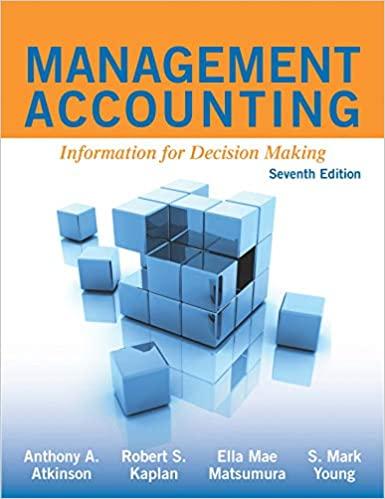
Case 4B-6 (Algo) Step-Down Method versus Direct Method [LO4-10, LO4-11) "This is really an odd situation," said Jim Carter, general manager of Highland Publishing Company. "We get most of the jobs we bid on that require a lot of press time in the Printing Department, yet profits on those jobs are never as high as they ought to be. On the other hand, we lose most of the jobs we bid on that require a lot of time in the Binding Department. I would be inclined to think that the problem is with our overhead rates, but we're already computing separate overnead rates for each department. So what else could be wrong?" Highland Publishing Company is a large organization that offers a variety of printing and binding work. The Printing and Binding departments are supported by three service departments. The costs of these service departments are allocated to other departments in the order listed below. The Personnel cost is allocated based on number of employees. The Custodial Services cost is allocated based on square feet of space occupied and the Maintenance cost is allocated based on machine-hours. Machine- Hours Direct Labor- Hours Department Personnel Custodial Services Maintenance Printing Binding Total Labor Square Feet of Hours Space Occupied 16,100 12,300 8,600 3,800 14,100 11,000 30,100 40,200 108,000 20,900 176,900 88, 200 Number of Employees 28 42 62 101 381 534 166,000 41,200 287,200 18,080 77,000 95,000 Budgeted overhead costs in each department for the current year are shown below. Personnel Custodial Services Maintenance Printing Binding Total budgeted cost $ 310,000 65,600 93,000 419,000 167,000 $1,054, 600 Because of its simplicity, the company has always used the direct method to allocate service department costs to the two operating departments Required: 1. Using the step-down method, allocate the service department costs to the consuming departments. Then compute predetermined overhead rates in the two operating departments. Use machine-hours as the allocation base in the Printing Department and direct labor-hours as the allocation base in the Binding Department 2. Repeat (1) above, this time using the direct method. Again compute predetermined overhead rates in the Printing and Binding departments 3. Assume that during the current year the company bids on a job that requires machine and labor time as follows: Direct Printing Department Machine Hours 2,100 Labor Hours 1,100 Required: 1. Using the step-down method, allocate the service department costs to the consuming departments. Then compute predetermined overhead rates in the two operating departments. Use machine-hours as the allocation base in the Printing Department and direct labor-hours as the allocation base in the Binding Department 2. Repeat (1) above, this time using the direct method. Again compute predetermined overhead rates in the Printing and Binding 3. Assume that during the current year the company bids on a job that requires machine and labor time as follows: Direct Machine-Hours Labor-Hours Printing Department 2,100 Binding Department 600 13,800 Total hours 2,700 14,900 1,100 a. Determine the amount of overhead cost that would be assigned to the job if the company used the overhead rates developed in (1) above. Then determine the amount of overhead cost that would be assigned to the job if the company used the overhead rates developed in (2) above. Complete this question by entering your answers in the tabs below. Reg 1 Reg 2 Req 3A Using the step-down method, allocate the service department costs to the consuming departments. Then compute predetermined overhead rates in the two operating departments. Use machine-hours as the allocation base in the Printing Department and direct labor- hours as the allocation base in the Binding Department. (Please enter allocations from a department as negative and allocations to a department as positive. The line should add across to zero. Do not round intermediate calculations. Round "Predetermined overhead rate" to 2 decimal places and rest of the answers to the nearest whole dollar amount.) Show less Custodial Personnel Services Maintenance Printing Binding s 310,000 $ 65,600 $ 93,000 $ 419,000 $ 167.000 (310.000) Departmental costs before allocations Allocations: Personnel costs Custodial services costs Maintenance costs Total costs after allocations Predetermined overhead rate 25,731 (91,331) 37.984 13,934 (144,918) 0 61,877 50,922 95,347 627,146 184,407 26,475 49,571 427,453 4.50 0 0 $ 3.03 S Reg Reg 2 > Complete this question by entering your answers in the tabs below. Req1 Real2 Req 3A Repeat requirement 1 above, this time using the direct method. Again compute predetermined overhead rates in the Printing and Binding departments. (Please enter allocations from a department as negative and allocations to a department as positive. The line should add across to zero. Do not round intermediate calculations. Round "Predetermined overhead rate" to 2 decimal places and rest of the answers to the nearest whole dollar amount.) Show less Personnel Custodial Services Maintenance Printing Binding $ 310,000 $ 65,600 $ 93,000 $ 419,000 S 167,000 Departmental costs before allocations Allocations Personnel costs Custodial services costs Maintenance costs Total costs after allocations Predetermined overhead rate 310,000 65,600 93,000 419.000 167,000 a. Determine the amount of overhead cost that would be assigned to the job if the company used the overhead rates developed in (1) above. Then determine the amount of overhead cost that would be assigned to the job if the company used the overhead rates developed in (2) above. Complete this question by entering your answers in the tabs below. Reg 1 Reg 2 Reg 3A Determine the amount of overhead cost that would be assigned to the job if the company used the overhead rates developed in requirement 1 above. Then determine the amount of overhead cost that would be assigned to the job if the company used the overhead rates developed in requirement 2. (Round your intermediate calculations to 2 decimal places and final answers to the nearest whole dollar amount.) Show less Total Overhead Cost Step-down method Direct method










